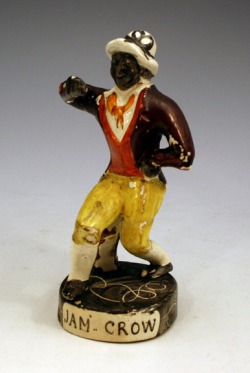Rice’s debut as Jim Crow at the Adelphi Theatre in London on 7 November 1836 was so successful that other plays were adapted to create a role for Jim Crow. Rice and Jim Crow became an international sensation and people of all classes capered to the ditty and printed images of Jim Crow proliferated.
|
Last posting looked at a classical figure. This time we move to the other end of the Staffordshire figure spectrum and look at a figure that very much reflected its times. While today the term "Jim Crow" has repugnant racial discrimination connotations, in the 1830s Jim Crow was the talk of London. Thomas Dartmouth Rice (1806-1860) is the man who gave us Jim Crow. Born and raised in New York, Rice trained as a woodcarver but he preferred the life of an itinerant entertainer. By 1828, he was earning his keep in the USA as a prop man and small-part actor. Between acts, he performed a shuffling, jiggling dance to the tune of a black American slave work song. The routine cruelly parodied the crippled movements of a slave named Jim Crow, who worked in the stables behind the theatre although his limbs were gnarled with arthritis. Rice performed his Jim Crow routine in blackface, thus creating a stereotype for black minstrelry that was to quickly become wildly popular. Rice’s debut as Jim Crow at the Adelphi Theatre in London on 7 November 1836 was so successful that other plays were adapted to create a role for Jim Crow. Rice and Jim Crow became an international sensation and people of all classes capered to the ditty and printed images of Jim Crow proliferated. Figures of Jim Crow are very rare. I have known of only one model (and only two copies of it)---until John Howard found his Jam Crow figure, shown here. Misspelling is common on Staffordshire figures because the potters were barely literate, so it is no surprise to find "Jim" endearingly spelled Staffordshire style!
0 Comments
Leave a Reply. |
Archives
February 2024
All material on this website is protected by copyright law. You may link to this site from your site, but please contact Myrna if you wish to reproduce any of this material elsewhere. |















